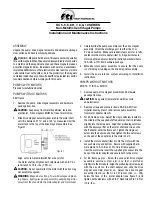
-3-
Safety Rules for Cordless/Corded Drills/Drivers
battery pack into a tool with the switch on
invites accidents.
Remove adjusting keys or wrenches
before turning the tool on.
A wrench or a
key that is left attached to a rotating part of
the tool may result in personal injury.
Do not overreach. Keep proper footing
and balance at all times.
Proper footing
and balance enable better control of the tool
in unexpected situations.
Use safety equipment. Always wear eye
protection.
Dust mask, non-skid safety
shoes, hard hat, or hearing protection must
be used for appropriate conditions.
Tool Use and Care
Use clamps or other practical way to
secure and support the workpiece to a
stable platform.
Holding the work by hand
or against your body is unstable and may
lead to loss of control.
Do not force tool. Use the correct tool for
your application.
The correct tool will do
the job better and safer at the rate for which
it is designed.
Do not use tool if switch does not turn it
on or off.
A tool that cannot be controlled
with the switch is dangerous and must be
repaired.
Disconnect the plug from the power
source before making any adjustments,
changing accessories, or storing the tool.
Such preventive safety measures reduce the
risk of starting the tool accidentally.
Disconnect battery pack from tool or
place the switch in the locked or off
position before making any adjustments,
changing accessories, or storing the tool.
Such preventive safety measures reduce the
risk of starting the tool accidentally.
Store idle tools out of reach of children
and other untrained persons.
Tools are
dangerous in the hands of untrained users.
When battery pack is not in use, keep it
away from other metal objects like: paper
clips, coins, keys, nails, screws, or other
small metal objects that can make a
connection from one terminal to another.
Shorting the battery terminals together may
cause sparks, burns, or a fire.
Maintain tools with care. Keep cutting
tools sharp and clean.
Properly maintained
tools with sharp cutting edge are less likely
to bind and are easier to control.
Check for misalignment or binding of
moving parts, breakage of parts, and any
other condition that may affect the tool's
operation. If damaged, have the tool
serviced before using.
Many accidents are
caused by poorly maintained tools.
Use only accessories that are recom-
mended by the manufacturer for your
model.
Accessories that may be suitable for
one tool may create a risk of injury when
used on another tool.
Service
Tool service must be performed only by
qualified repair personnel.
Service or
maintenance performed by unqualified
personnel may result in a risk of injury.
When servicing a tool, use only identical
replacement parts. Follow instructions in
the Maintenance section of this manual.
Use of unauthorized parts or failure to follow
Maintenance Instructions may create a risk
of shock or injury.
Hold tool by insulated gripping surfaces
when performing an operation where the
cutting tools may contact hidden wiring
or its own cord.
Contact with a “live” wire
will make exposed metal parts of the tool
“live” and shock the operator.
Do not drill,
fasten or break into existing walls or other
blind areas where electrical wiring may exist.
If this situation is unavoidable, disconnect all
fuses or circuit breakers feeding this
worksite.
Always hold the tool with both hands.
If
the bit jams two hands will give you
maximum control over torque reaction or
kickback.
Always wear safety goggles or eye
protection when using this tool. Use a
dust mask or respirator for applications
which generate dust.
Secure the material being drilled. Never
hold it in your hand or across legs.
Unstable support can cause the drill bit to
bind causing loss of control and injury.
SM 2610995792 10/00 10/9/00 11:32 AM Page 3




































